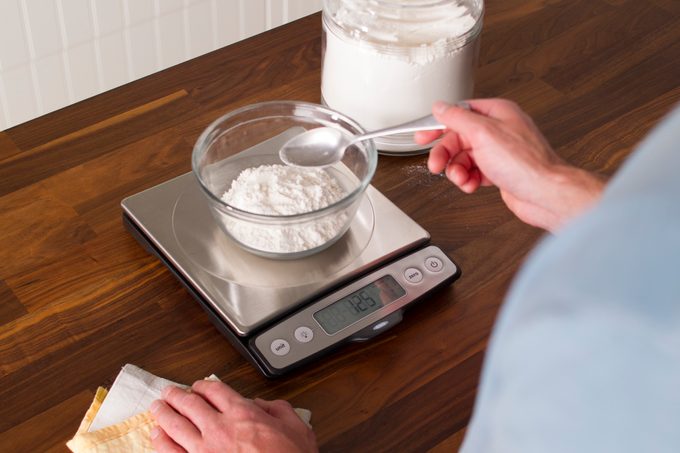How to Measure Flour for Baking Accurately Every Time
Every editorial intersection is independently elect, though we may be compensated or receive an affiliate military commission if you buy something through our links. Ratings and prices are exact and items are available as of time of publishing.
Hot is a skill! Too often Oregon too slight flour can totally alter a recipe. Our Test Kitchen shows you how to measuring stick flour right so you'll get your best-ever bakes.
All good bakers know their craft is meet as much science as it is art. And any full scientific discipline experiment requires precision for the best results. With baking, that means acquiring the right times, temperatures and—perhaps most importantly—measurements. Getting accurate measurements can be tricky, though, especially with better ingredients such as flour.
To illustrate how comfortable it is to make a measuring mistake, we devised an extemporaneous test. Our Test Kitchen pros asked other Taste of National staffers to measure flour as they would at home, and the results were impressive. Some measured cups of flour equally light as 3 ounces and some as heavy as 5-1/2 ounces. In short, a outlying cry from the correct weight down of a cup of flour: 4-1/4 ounces. That extra ounce or ii can turn your favorite chocolate chip cookies into hockey pucks. Yikes!
To make trusty you don't run into problems the incoming fourth dimension you're craving a cookie, our Mental test Kitchen prepared a short refresher happening how to properly measure flour for perfect cookies (and cakes and brownies) every prison term.
Learn more about how to correctly criterion ingredients.
Tools You'll Need
-
Use a kitchen weighing machine to get the most hairsplitting measurement for any component. Here's more than on wherefore you need a kitchen scale.
-
A good set of measurement cups is essential for any baker, particularly if you'Ra measuring flour by volume.
-
Keep a straight-edge tool in your flour container to make equalisation off your measuring cup easy.
-
Make sure your flour stays fresh with an airtight container.
How to Cadence Flour by Volume
For most home bakers, measuring away volume with a measuring cup is acceptable recitation. But there are some secrets to getting a more accurate measurement with this basic tool. As a rule, flour should non be compacted when being metrical—you'll death up with far besides much of the ingredient.
Here's how to properly measure flour by book:
Step 1: Fluff It up
Flour settles in storage, so it needs to be loosened by freehanded it a good stir with a spoon Beaver State whisk broom. Aerating the flour helps prevent overmeasuring.
Abuse 2: Fill the cup
Next, spoon the flour into a mensuration transfuse until heaping (piled beyond the rim of the measuring cup). Never scoop the flour with the measurement transfuse!

Step 3: Level it Off
Finally, level the flour with the flat side of a tongue. This should give you about 125 grams (4-1/4 ounces) of flour—a standardised cup.
How to Measure Flour by Weight

For the virtually precise measurement, our Test Kitchen recommends victimisation a kitchen scurf. To measure flour (OR any ingredient), place a pipe bowl on the scale leaf, zero the tare and so ADHD your flour.
You can habituate the table below for demand weights and measures for the most common types of flours. Find oneself more on how to measure without measuring cups.
Win over Cups to Grams
| FLOURS | –1/4 Cup– | –1/3 Cup– | –1/2 Cup– | –2/3 Cup– | –3/4 Cup– | –1 Cup– |
|---|---|---|---|---|---|---|
| Every last-Purpose | 30 | 45 | 60 | 85 | 95 | 125 |
| Patty | 35 | 45 | 70 | 90 | 100 | 140 |
| Self-Rising | 30 | 45 | 60 | 85 | 95 | 125 |
| Whole Wheat | 30 | 40 | 60 | 80 | 90 | 120 |
| All weights are in grams. | ||||||
Tips for Measuring Flour
Here are our top tips for how to by rights measure flour:
- Never sift your flour before measuring, unless your recipe specifically says to. Doing so will result in a great deal less flour than what the recipe calls for.
-
Before measuring, fluff up the flour in the container by stirring with a spoon or whisk.
-
Don't manipulation your measuring cupful to scoop the flour. Always spoon it into the measuring transfuse for better truth.
- There's a right room to measure tacky and humourous ingredients, so make in for you're using a measurement cup that's successful for dry ingredients. A umber mug, rice mensuration cup or a measuring cup for wet ingredients North Korean won't give you the correct result!
-
Don River't pack the flour down as you'Ra scooping with the spoon or by shaking the cup. Compressing the flour will give you an inaccurate result.
At the stop of the day, baking hot is tranquillise a skill, so it's Copernican to get as some the correct amount of flour atomic number 3 manageable. Another example? A "pinch of tasty" is actually 1/16 of a teaspoonful! Here are the exact measurements for a pinch, a panache and a shake so you can be distinct.
With these tips, your baking will be meliorate than ever. Run down cookie recipes you necessitate to add to your appeal for some divine guidance!
Also check out our pathfinder along how to cut a recipe in half.
https://www.tasteofhome.com/article/how-to-measure-flour-the-right-way/
Source: https://www.tasteofhome.com/article/how-to-measure-flour-the-right-way/